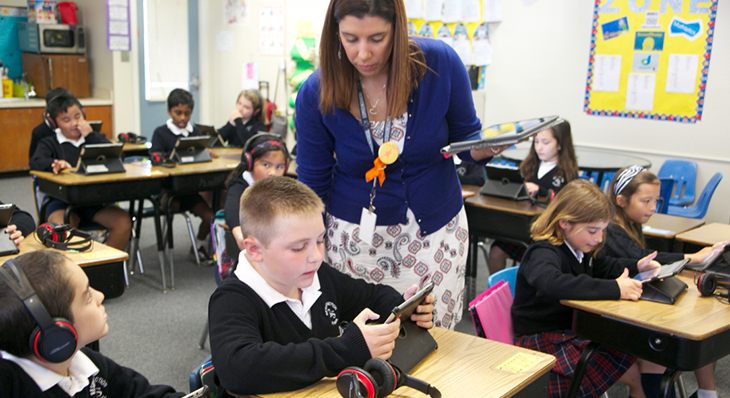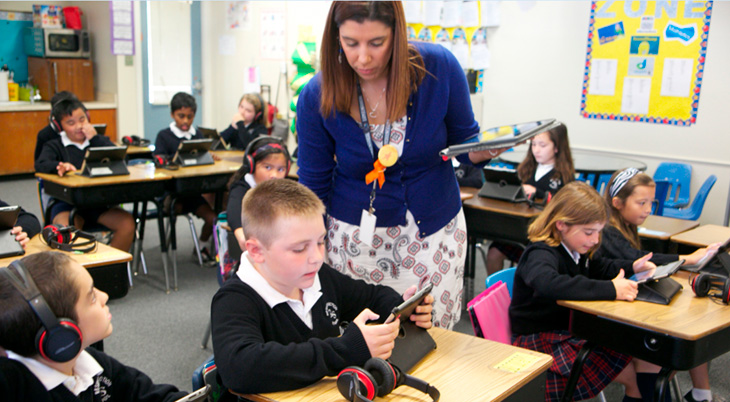
Nearpod: A “Classroom Management System” that empowers teachers and improves classroom interactions
Our CEO, Guido Kovalskys, shares the ideas that built Nearpod and how the platform is empowering teachers through interaction, personalization, and feedback.
Our history
At Nearpod, we are convinced that learning is primarily a social experience, and we’ve set out to build the perfect tool to address the need for close interactions in the classroom. Many research studies have found that teacher and peer interaction is important for optimal active learning, particularly on activities and assessments calling on higher-order thinking. Collaborating with other learners, sharing content, exchanging ideas, and getting feedback from teachers and other peers are among the most effective ways to learn.
As with many other things in life, innovation is a process. The idea of building Nearpod came after many years creating interactive learning content for large customers such as Disney, Nickelodeon, LeapFrog, and Barnes & Noble. As developers, we noticed that most software tools on the market were promoting asynchronous solutions for learning. However, few of these products were solving the problem of student engagement in the classroom. My team and I saw a clear need for a mobile technology that empowers teachers to engage students synchronously and collaboratively–what I now think of as a “Classroom Management System.” That’s how Nearpod was born.
Behind the magic: How Nearpod works
Nearpod enables teachers to create and share interactive materials with their students’ mobile devices in real-time. We have combined presentation, collaboration, and assessment tools into one easy-to-use platform that runs on all devices (iOS, Android, Windows 8, Mac, PC, and all other browser-enabled devices). Instead of viewing static presentation slides from afar, students access lessons right in their hands; instead of delivering one-way communication, instructors incorporate activities and formative assessments that provide interaction and feedback.
With so much tech in the classroom, what’s the role of the teacher?
With the widespread penetration of mobile devices and computer-based assessments, many schools and districts are investing in 1-to-1 programs (one device per student) and/or establishing BYOD (Bring Your Own Device) models. Often, these technologies are expected to be silver bullets for solving education challenges. However, teacher quality remains a central variable in student achievement outcomes. Our own observations of Nearpod use in schools all over the world corroborate the research findings that teachers must have knowledge, skills, and motivation to use these educational technologies in meaningful ways. Teachers, not tools, are the silver bullets.
Merely putting more technology in classrooms is not our goal, nor will this approach prepare students for the challenges of work, life, and citizenship in the 21st century. Instead, we seek to empower educators through technology that increases human interaction, personalization, and feedback–because that’s where the real educational impact is made. We have always worked closely with teachers to ensure that they can use our product in compelling, effective, practical, and sustainable ways. There was a defining moment when one of our early adopters told us, “I was wondering how all of these mobile devices were going to be used in the classroom, and now that I see Nearpod, I totally get it.” Since then, we have done hundreds of pilots in schools, and regularly hear from the teaching community about the many ways Nearpod enables them to explore innovative instructional strategies, from making students into content creators and producers to delivering instruction on a snow day.
Instructional time is precious in teaching, and one of the most important ways in which we empower teachers is by giving them a window into what’s working in the classroom so that they can use that time efficiently. Nearpod’s interactive and formative assessment activities produce data and surface patterns that teachers can use to gain insight into, and prioritize their instruction. “I have instant feedback on student comprehension,” says 7th Grade Math Teacher, Tina Hu “I can automatically see who got the correct answer and who didn’t. I can target the students who are struggling and give them extra help when they need it”

The power of crowdsourcing
Nearpod empowers teachers by making them partners in curriculum development. Through the Nearpod Authors Program, teachers join a community of educators to publish and sell lessons in our Content Store, where all materials are carefully curated to make sure they are educationally sound. In addition to making extra income, teachers build their content and craft by reviewing each other’s work. “I think the best part of being in the Authors Program is the ability to share exciting and engaging lessons with other teachers,” says Nearpod Author and Elementary Teacher Mara Merly Delgado, one of the top sellers in the Store,
In addition, Nearpod collaborates with some of the most innovative content publishers like CK-12 Foundation and Common Sense Media to offer high quality and standards-aligned lessons that teachers can download, adapt, and supplement to fit their classroom context and students’ needs. This model supports the development of innovative and creative materials, and can also lead to better pedagogy.
Your turn
Get started with the free version of Nearpod and find out about site licenses at www.nearpod.com, and join our Nearpod Community to let us know what you want to see next.


